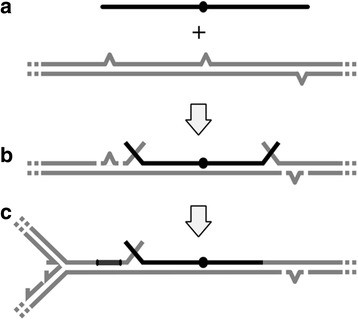Fig. 3.

Formation of DNA double strand-breaks conferred by nucleotide excision repair during natural transformation. a: Grey lines: genomic DNA; grey spikes: UV-induced lesions. Black line: taken-up DNA single-strand with genetic marker (oval). b: Generation of DNA single-strand-breaks by UvrAB-directed, UvrBC-initiated cleavage of the damage-containing strand upstream and downstream of the lesions, and by RecA-mediated strand invasion of the taken-up DNA and cleavage of the displaced DNA strand. c: Partial repair of single-strand breaks: 1. by removal of the lesion-containing single-strand fragment (left lesion), fill-in synthesis, and covalent ligation (dark grey; catalysed by UvrD, DNA polymerase I, and DNA ligase, respectively); and 2. by covalent joining of the invaded taken-up strand with the genomic DNA at one side (downstream of the marker). Single-strand breaks persist when the UV lesion-containing strands are not removed (right lesion) and when an invaded DNA strand remains unligated at one end (upstream of the marker). One-sided ligation of the invaded DNA strand is common (see text). Following DNA replication (indicated by a replication fork approaching from the left end), single-strand breaks are converted into potentially lethal double-strand breaks
